Expeditions for a prisoner of war, unexpected attacks on enemy positions. The soldiers of the Carpathian Brigade had such adventurous escapades in their blood. A real Kmicic fantasy made their night patrols during the defense of Tobruk legendary
The Independent Carpathian Rifle Brigade was established in 1940 in Syria controlled by the French. It was mainly used by veterans of the Polish campaign in 1939, who managed to get out of the occupied country by various routes. As Norman Davies writes in "The Trail of Hope ...", the individual was:
designed on the model of the elite French formation Chasseurs Alpins, which specialized in fighting in the mountains (...); the goal was to achieve the standard size of a division in the Levant Army, i.e. 208 officers and 6,840 soldiers.
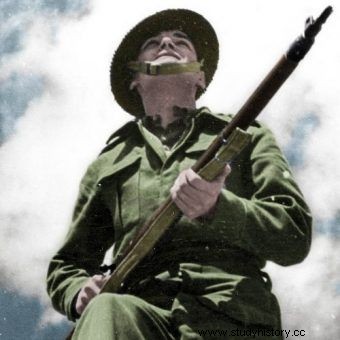
It was better not to mess with the soldiers of the Carpathian Brigade (photo:public domain; colorization:RK).
After the capitulation of France, the brigade was subordinated to the British and transferred to Palestine, and then re-formed according to the British pattern.
Don't mess with Polish soldiers
It was a unique unit, made up of volunteers who often risked their lives to reach the Middle East . The soldiers themselves had a high self-esteem. A great example of this was an incident in Alexandria.
Our soldier was accosted by two British gendarmes: hello, Esma, come back! In this way, the English contemptuously recalled the locals. The Pole marched on as if nothing had happened. The gendarmes renewed their call, this time in a much sharper tone. Around a small crowd of Arabs has gathered to ventilate the oncoming drake.
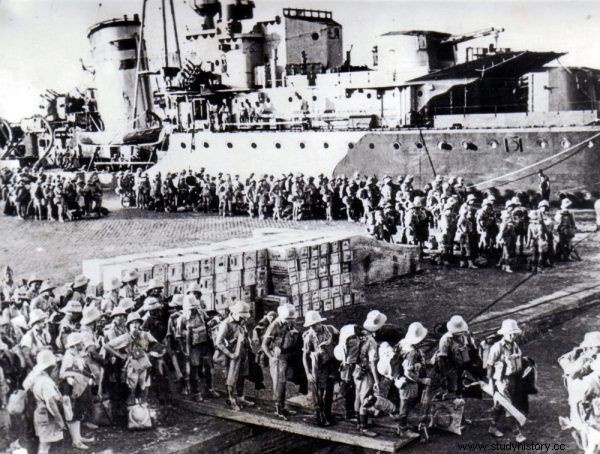
The soldiers of the Carpathian Brigade arrive in Tobruk (photo:public domain).
When the Pole realized that it was him, he turned back. He walked calmly and steadily towards the British. Without saying anything, he walked over to the gendarme who called him, and with a beautiful crescent blow blew him away just in front of him .
The second Englishman was literally stunned, not sure what to do in this situation. Our soldier turned to him and said loudly: do you also want to get in the teeth for addressing the Polish soldier inappropriately ? He didn't even react and took care of the downed friend.
Tobruk Rats
In mid-August 1941, the brigade reached Tobruk. The defense system of the fortress there consisted of three lines of fortifications running along the deep wadi , that is jars. The defense perimeter was 50 km and the radius was 12-15 km. The individual resistance points were spaced 500-1000 m apart. They were surrounded by barbed wire barriers, minefields and an anti-tank ditch.
Initially, the Polish brigade took over the southern section of the defense, and at the beginning of October, the western one. At that time, units of two Italian divisions were located opposite. Between them lay the ominous hill of Ras el Medauar, manned by the Germans, heavily fortified, laden with machine guns and artillery. The enemy had constant insight into the positions of Polish soldiers from there.
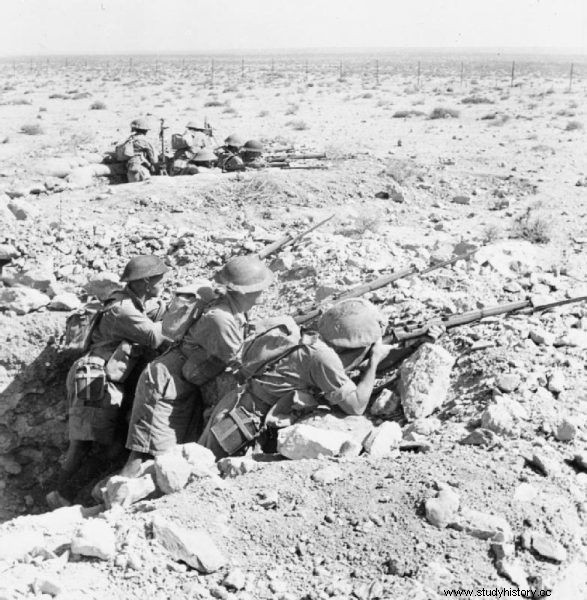
This is what the Allied trenches at Tobruk looked like. Australian soldiers here at their posts (photo N. Smith, from the collection of the Imperial War Museum, no. E 4792; public domain).
The service in Tobruk was physically and mentally exhausting. It was unbearable heat and chamsiny, that is, dry and gusty winds. Water was constantly rationed, often stinking and brackish. The food consisted only of canned food. Only ammunition was in abundance. There was also a common feeling of isolation in full of rats, sandy and rocky trenches .
The fight was very specific. During the day, artillery from both sides and the German air force carried out lively operations. The actual clashes took place at night. At that time, raids were made into the enemy's position, conducting reconnaissance, disrupting the enemy's command and communication system and taking prisoners. Poles turned out to be true masters in this field .
A worthy successor to Kmicic
The most famous Carpathian Zagończyk was Officer Cadet Adolf Bocheński, a soldier of the Carpathian Lancers Regiment. Conducted fifty patrols and forays safely . In order to crawl to the enemy's position in total darkness, it was necessary to know the distribution of his firing points and barbed wire passages, as well as the arrangement of minefields. Well, it was even necessary to avoid the corpses lying in the foreground, which were often mined .
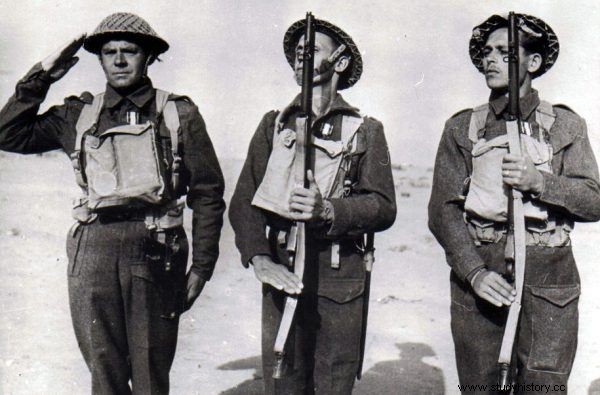
Carpathian Brigade soldiers decorated for fighting in Tobruk (photo:public domain).
The cadet's most famous action was the blowing up of the Italian artillery tower on September 15, 1941. It was a wooden structure that allowed enemies to observe Polish positions. Interestingly, the Carpathians had the same tower with exactly the same function.
Both sides made it a point of honor to destroy the opposing turret . The artillery hit them mercilessly, but did not cause any significant damage. Until one day Polish soldiers saw that our structure was heavily tilted and the Italian one was doing well. Bocheński decided to take matters into his own hands.
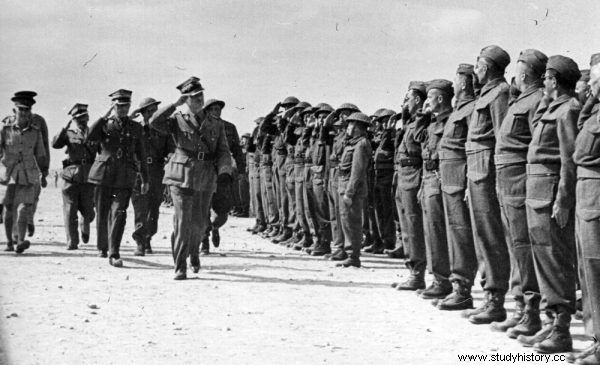
General Władysław Sikorski and the soldiers of the Independent Carpathian Rifle Brigade, November 1941 (photo:public domain).
The shooter Stanisław Jakubas volunteered for the raid with the cadet. They both stuffed their pockets with dynamite, grenades, a fuse, and kerosene bottles. When it got dark, they headed towards the enemy tower about 2 km away. The experienced Bocheński was the leader. First, they advanced heavily stooping, counting the steps and maneuvering along the compass, then on all fours, and finally crawling.
When they got there, it turned out that Bocheński did not take dynamite with him! Resigned, they were about to return when Jakubas came up with the idea to use a beam of grenades. They located the tower, placed their improvised explosive at the supports, poured kerosene over the whole, set fire to the fuse and began to retreat.
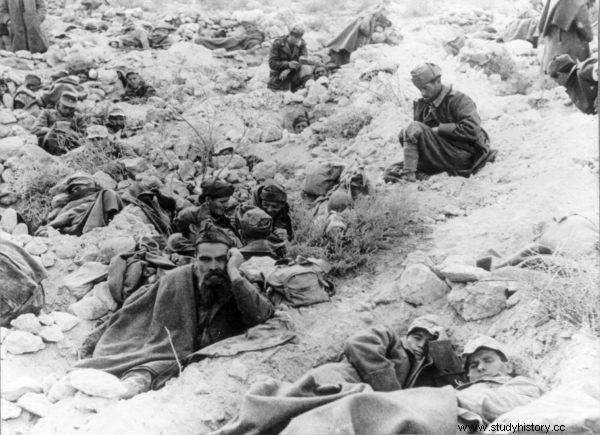
Italian and German prisoners of war in Tobruk. Maybe the Poles took them captive? (photo from the collection of the US Library of Congress, public domain).
They didn't crawl out a hundred yards when an explosion hit the area and the enemy tower caught fire. Both heroes happily returned. On the next morning, there was no sign of the Italian tower, and Poland stood proudly though crookedly in its place.
You must have fantasy!
It was an unbelievable adventure that 2nd Lt. Antoni Ruschill. Alone, he broke through minefields, barbed wire, and ditches and reached enemy lines. Dressed in a driver's overalls, with a bandaged head, pretending to be an Italian, drove around the enemy's facilities in an accidentally stopped German truck. He located heavy artillery positions, vehicle clusters, and warehouses. Then he drove an Italian truck pretending to be a German.
During the night, the Pole broke through to our positions. For his feat he was simultaneously arrested for a couple of weeks with suspension, the Cross of Valor and an invitation to the commander of the fortress , General Leslie Morshead, for dinner with a bottle of beer.
Mamma mia! Polacchi!
The history of the defense of Tobruk in golden letters also included the mission carried out on the night of October 12-13, 1941. A rushed squadron of Carpathian lancers under the command of Captain Antoni Smodlibowski set out on a patrol. The Poles went with a firm resolve to bring the prisoners of war, for whom General Morshead had been striving for several weeks with poor success.
The surprise was utter. In the night battle with bayonets, the Poles did not give the Italians any chance. An infantry company and a platoon of heavy machine guns supporting it were smashed. The uhlans, heated by the battle, forgot even about their essential task. Only the shouts of prisoner, take a prisoner of war reminded them of that!
The battlefield was searched and three very frightened macarons were found . Two of them, taking advantage of the stares of the Poles, quickly gave a leg. The third was being watched more carefully.
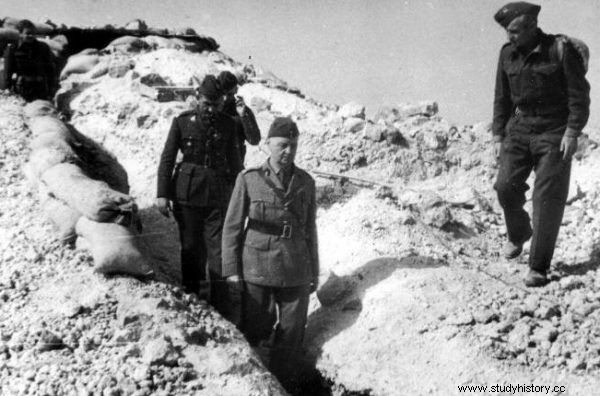
Gen. Sikorski in Tobruk (photo:public domain).
The captured turned out to be an invaluable asset. He was a concrete mixer by profession and from then on he worked on the construction of bunkers in Tobruk, and he knew the location of his troops very well. Information from his interrogation reached the British headquarters in Cairo. Smodlibowski received Virtuti Militari and the British Military Medal for this action.
Perseverance and sacrifice
The defense of Tobruk has become a symbol of steadfastness, so it is worth remembering that Poles also played a part in it. The Independent Carpathian Rifle Brigade lasted at its post for four months. During that time, over 100 Polish soldiers were killed, about 400 were wounded, and a further several hundred fell ill due to difficult living conditions.
After Tobruk was unlocked, the unit continued to fight in North Africa. She was withdrawn from the front in March 1942 and sent to Palestine. There, on May 3, it was disbanded and the 3rd Carpathian Rifle Division was created on its basis.
Bibliography:
- Witold Biegański, They were called Tobruk rats , Ludowa Spółdzielnia Wydawnicza, Warsaw 1988.
- Norman Davies, Trail of Hope. March across three continents , Rosikon Press, Izabelin 2015.
- Stanisław Muranowski, Fortress in the desert , MON Publishing House, Warsaw 1959.
- Polish armed act in World War II. Fights of Polish formations in the West 1939–1945 , collective work, MON Publishing House, Warsaw 1981.
- Mieczysław Pruszyński, From Kock to Gazelle Sources , MON Publishing House, Warsaw 1988.
- Tadeusz Radwański, They called us Carpathians , MON Publishing House, Warsaw 1978.
- Olgierd Terlecki, Desert combat routes , National Publishing Agency, Krakow 1983.
- Polish Army 1939-1945, Barwa i Broń , collective work, Interpress Publishing House, Warsaw 1990.
